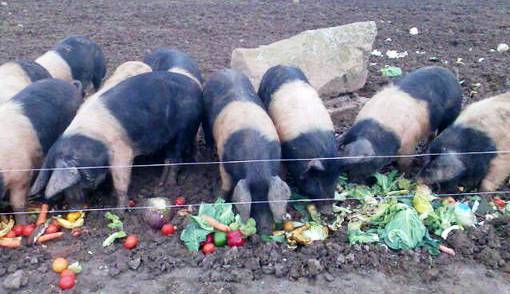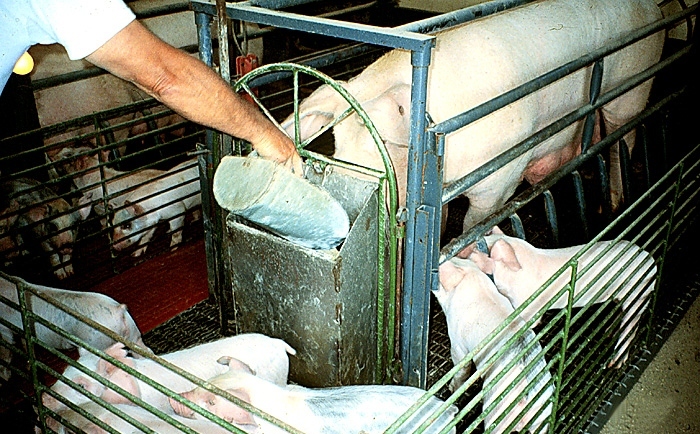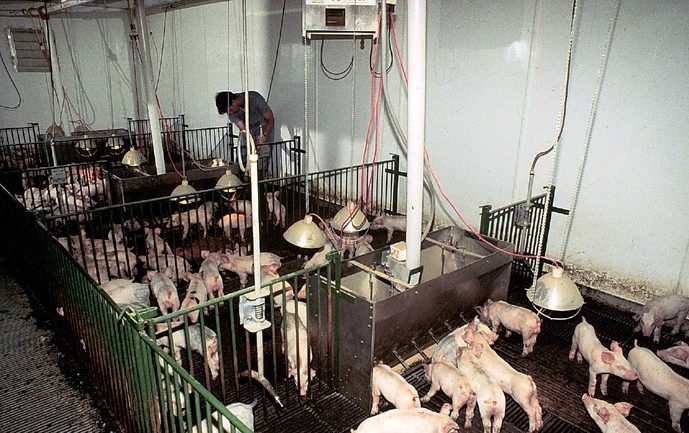FEEDING MANAGEMENT
-
Pigs are monogastric animals and can utilize fibrous food only to a limited extent. Adult pigs can utilize fibrous food better than young stock.
-
Part of the protein in the diet of pigs should come from animal source such as fish, meat etc.
- Pigs should be fed at regular intervals.
- Fresh feed should be put only after removal of the previous feed from the feed trough.
- Pig rearing based on commercial pig feed is not economical and hence feeding based on swill is recommended. On an average, pig requires 4-8 kg swill per day.
- All categories of pigs can be given small quantity of fodder or may be sent to pasture.
- Ad libitum feeding using an automatic feeder (which can be fabricated using 200 litre oil drum) may be practiced for weaned pigs to avoid post-weaning weight depression

Feeding
Nutrients requirement of breeding stock
Type |
Breed Gilts |
Lactating gilts & sows |
Young boars & adult boars |
Live weight (kg.) |
110-250 |
140-250 |
110-250 |
Energy and protein |
DE (M cal/kg) |
3.3 |
3.3 |
3.3 |
ME (M cal/kg) |
3.17 |
3.17 |
3.17 |
Crude Protein (%) |
14 |
15 |
14 |
Inorganic nutrients (%) |
Calcium |
0.75 |
0.75 |
0.75 |
Phosphorus |
0.5 |
0.5 |
0.5 |
Salt |
0.5 |
0.5 |
0.5 |
(Source: National Bank for Agriculture and Rural Development)
Nutrient requirement of growing stock
Type |
Weaning |
Growing |
Finishing |
Live weight (kg) |
5-12 |
12-50 |
50-100 |
Daily gain (kg) |
0.3 |
0.5 |
0.6 |
Energy and protein |
DE ( M cal/kg) |
3.5 |
3.5 |
3.3 |
ME (M cal/kg) |
3.36 |
3.36 |
3.17 |
Crude Protein (%) |
22 |
18 |
14 |
Inorganic nutrients (%) |
Calcium |
0.8 |
0.65 |
0.5 |
Phosphorus |
0.6 |
0.5 |
0.4 |
Sodium |
-- |
0.1 |
-- |
Chlorine |
-- |
0.13 |
-- |
(Source: National Bank for Agriculture and Rural Development )
Miscellaneous feeds which can be fed to pigs: Swill (kitchen waste including left over of human food, vegetables, meat and fish cuttings): Composition and quantity vary so greatly that it is difficult to indicate feeding values. It has been observed that pigs weighing 30 kg reached a body weight of 70 kg in 70 days when fed exclusively on kitchen waste. Ensure that swill feed is not old and putrified. On an average 4 – 8 kg swill is needed per pig per day.
Other feeds used for feeding pig
Item |
Incorporation level up to (%) |
Tapioca starch waste |
15-20 |
Rubber seed cake |
15 |
Tamarind seed roasted |
20 |
Tea waste |
20 |
Meat offal |
20 |
(Source: Kerala Agricultural University)
Feeding of boars
A breeding boar requires 2-2.5 kg concentrate per 100 kg weight depending on the age, condition and breeding demand. Feed allowances should be so adjusted that the pig is neither fatty nor run down. Greens should be provided if kept indoors. Year-round pasture is excellent if it could be provided from the stand point of providing both the needed exercise and valuable nutrients.
Feeding of female
The demands resulting from pregnancy and need for conserving nutrients for ensuing lactation are accelerated during the later stage of pregnancy. The increased needs are for proteins, vitamins and minerals.
Mature sows gain 30-35 kg and gilts 40-45 kg during pregnancy. Feed should be so regulated that sows and gilts are never over fat or thin. Individual feeding is preferred.
Flushing is a practice of giving extra feed to sows and gilts from 1-2 weeks prior to mating and returns to normal feeding after mating.
Feeding of Farrowing Sow and Litter
Feed lightly with bulky laxative feed immediately before and after farrowing. Bring the sow to full feeding in 10 days. Plenty of greens may be provided. Feed allowance may be calculated as 2.5-3 kg/100 kg body weight plus at the rate of 0.2 kg feed per piglet with the sow. Thus, a sow weighing 100 kg with 8 piglets should receive 4.6 kg feed per day. The piglets may be provided with special nourishing diet called creep feed separately

Feeding of Lactating Sows
Creep feeding:
The practice of self-feeding concentrates to young piglets in a separate enclosure away from their mother is known as creep feeding. Creep feed should be given when piglets are two weeks old. Each active and healthy piglet may consume about 10 kg feed before reaching the age of 8 weeks and two-third of this consumed between 6-8 weeks.
Feeding of growing and finishing pigs:
The pigs may be given complete feed they can consume to attain maximum growth. Alternatively, they may be fed a fixed quantity twice or thrice a day. Yet another method that they may be fed all the quantity they consume within a fixed time of 30-45 minutes or so.
On an average, the post-weaning feed conversion efficiency till market weight may be about 4 i.e. this much quantity of feed would be used by the pig to gain one kg of weight. However, it varies considerably with age and ambient temperature. Protein requirements are greater during early life. As fattening progresses, protein per cent in the ration may be decreased.
This period may be considered from weaning (9-10 kg) to the slaughter weight of 90-100 kg. Entire males, castrates and females can be fattened for meat purposes. The entire males and females may have higher feed conversion efficiency than castrates. Castration if required may be done at the age of 3-6 weeks. Castrates are more docile and put on slightly more fat. Growers may be grouped according to sex, size and weight as uniformly as possible. The difference in weight between the small and large pig in a lot should not be more than 20%. Up to 15 pigs may be conveniently put together in a pen. In summer, sprinklers, wallowing tanks etc. may be provided in addition to shades to cool pigs. Poor growers may be identified, culled and removed from the lot at the earliest. Deworming may be done two weeks after weaning and may be repeated once in two months if necessary.

Weaned Piglets
(Source: Kerala Agricultural University)
Orphan pigs:
When a sow dies or fails to produce milk or does not claim her pigs, the piglings should be promptly shifted to a foster mother. Some sows may refuse to suckle alien piglings. Care should be taken to simulate the conditions including the odour and body size of piglings when admitted to a foster mother or another suckling sow. If a suckling sow is not available, hand feeding would be necessary. Cow’s milk is the best substitute for sow’s milk. Buttermilk or sweet skim milk can also be used. Each pigling may consume 300-500 ml milk per day. Best results may be secured by feeding 5-6 times a day for the first few weeks and thereafter the frequency may gradually be reduced to 2-3 times. Any standard vitamin preparation two or three times the quantity used for infants may be administered to the piglings until they start taking feed. Injectable iron preparation (e.g. Imferon) may be given as usual. A 60-Watt electric bulb may provide enough warmth for the piglings during the early days of life.
Expected live weight for age under good feeding and management
Age (weeks) |
Live weight, kg |
4
8
12
20
28 |
4
10
20
50
85 |
Approximate water requirements of pigs per day
|
Water Requirements (litres) |
8 |
3 |
20 |
7 |
28 |
8 |
Pregnant pig |
First 3 months |
12 |
Last 3 months |
15 |
Lactating Sow with 5-8 Piglets |
25 |
Lactating Sow with 10-12 Piglets |
30 |
Boar |
20 |
(Source: Kerala Agricultural University) |



